Original Owner: 200K miles later, this Mustang is still racing
Welcome to Original Owner, a series showcasing—you guessed it—people who bought a classic car new and still own it. The cars don’t need to be factory-original, just still in the hands of the first owner and still getting driven. —Ed.
In March 1966, Richard Klein walked into Larsen Ford in White Plains, New York and bought a brand-new Shelby GT350 for weekend rallying and daily driving. Fifty-seven years and nearly 200,000 miles later, this retired junior-high school industrial arts teacher is still driving and rallying his legendary high-performance Mustang.
Before buying the Shelby, Klein and one of his two rally partners over the years, Walter Eisenstark, were using the latter’s Plymouth Barracuda Formula S. Klein had also previously rallied in a Renault, an Austin-Healey, and two different Corvairs.
Time-speed-distance rallying, or “TSD” as it was known, had become popular with sports car drivers and offered enthusiasts opportunities in numerous local, regional, and national rallies. The “International 1,000” rally organized by the MG Club of Long Island, aka the “MG 1000,” stretched over four to five days and about 1200 miles over all types of roads, paved and unpaved.
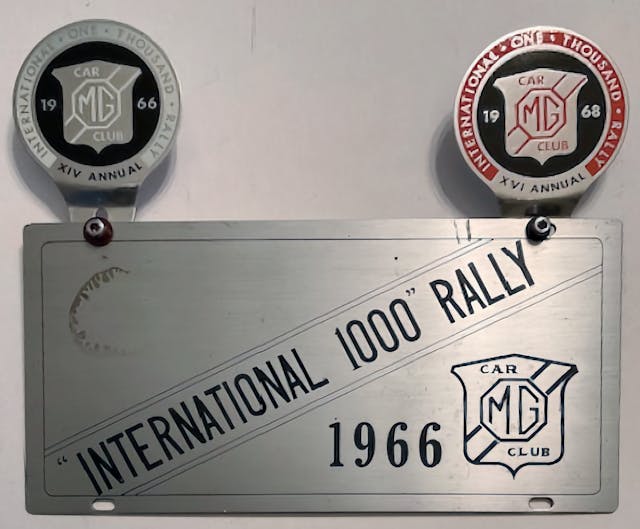
“We did so much rallying, we decided we needed a specific car,” Klein says. “Walter used the Barracuda for daily transportation, and he didn’t want it set up with rally equipment. So, I bought the Shelby.”
Klein would run so many rallies in the Shelby that, by 1970, it had accumulated 100,000 miles. (His local daily commute was less than 10 minutes.) He drove the GT350 in long-distance rallies into the mid-1970s and used it as his daily driver through the late 1980s, “when it became too valuable to do so,” he said.

By 1990, the car wore 125,000 miles. It looked and felt tired. A general refurbishment and repaint by one of Klein’s former students revived the GT350, and he continued to use it for local rallies, long-distance tours, and everyday fun. Klein has also driven the GT350 to Shelby American Automobile Club conventions and shown the car in numerous concours events, most recently the 2023 Greenwich Concours d’ Elegance.
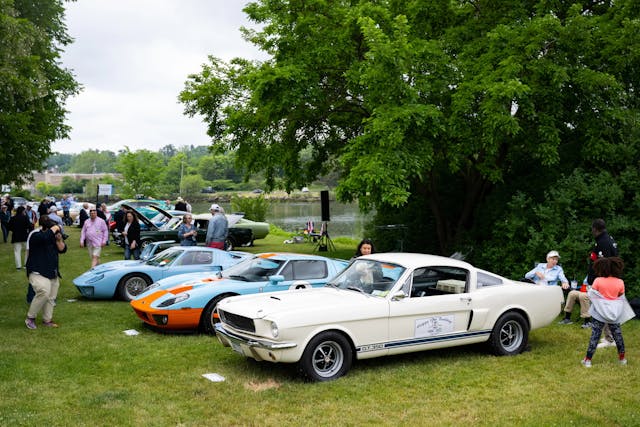
Rallying Mustangs
For those not familiar, TSD rallies emphasize precision driving and solving “traps” to reach checkpoints as closely as possible to pre-measured times. Teams lose points for being early or late to checkpoints. Having a fast, agile car helps make up lost time when necessary.
In 1969, Ford took notice of rallying and backed two teams running Mustang Mach 1s to help promote the then-new performance model. A Mach 1 won the SCCA Manufacturer’s Road Rally Championships in 1969 and in 1970, after which Ford exited the series. Klein and his wife, P.K., remain friends with one of the team champs from New Jersey, Kathy Bohl.
The couple are members of Connecticut/New England Café Racers, a Sarasota Café Racers car guy lunch group satellite in Fairfield County, Connecticut. Besides the GT350, they own and drive a ’66 Mustang convertible, a 2005 Mustang GT convertible, a 2007 GT500, an Alfa Romeo, a BMW 2002, a Jaguar XJ6, and a De Tomaso Longchamp.
1966 Shelby GT350: Factory basics
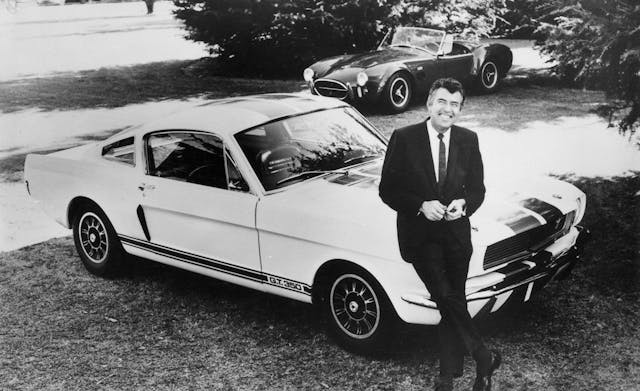
Two years after unleashing the Ford-powered AC Cobra, retired Le Mans–winning racer Carroll Shelby answered Ford’s request to give the sporty new Mustang more bite. The result, the Shelby GT350, became a giant-killer in SCCA road racing and gave the new pony car genuine street cred. The Shelby Mustang program continued until 1970 with just over 14,900 total cars built.
The 1965–66 GT350s were the wild ones. As detailed in Hagerty’s 1965–66 Shelby GT Buyer’s Guide, a larger Holley carburetor, aluminum dual-plane intake, and “tri-y” headers turned the Mustang’s optional K-code High-Performance 289 cubic-inch V-8 into the 306-hp Cobra engine. Lower weight (the back seat was deleted) and a combination of Ford and aftermarket chassis parts made the Shelby-ized Mustang a tenacious corner carver. Shelby beefed up the drivetrain using a close-ratio Borg Warner T-10 four-speed manual transmission housed in an aluminum case plus a ratchet-type limited-slip differential with 3.89:1 axle ratio made by Detroit Locker.
Contemporary road tests recorded 0-to-60 mph in about 6.5 seconds for the GT350 versus about 7.5 for a stock K-code Mustang, and the quarter mile in under 15 seconds at over 90 mph. Shelby also built three dozen 1965 GT350R racers with further mods. The effort paid off: Shelbys won the SCCA B-Production national championship in 1965, 1966, and 1967.

The 1965 street GT350 proved a bit too raw, however. Just 526 were sold. Numerous changes for 1966 calmed the beast without blunting performance. Key among these were a more street-friendly Traction-Lok limited-slip diff replacing the noisy Detroit Locker, rear-exit exhaust replacing side-exit pipes, and “underride” traction bars replacing “override” bars.
Also for 1966, a performance-tuned automatic transmission and fold-down rear seat joined the option list. More exterior colors were offered beyond the ’65 model’s sole choice, Wimbledon White. The changes worked. Shelby converted nearly 2400 of the 1966 Mustangs into GT350s, including 1001 GT350H models built for car-rental giant Hertz.


Legendary Shelby Dealer
Klein bought his car from a dealer and salesman that had become pivotal to the Shelby Mustang program. Larsen Ford was the country’s #1 Shelby dealer (out of 64) when Kline bought his car there, thanks to the efforts of one young, dynamic racer and salesman, Bill Kolb, Jr. He drag-raced a ’63 Ford Galaxie 427 lightweight, a ’64 Fairlane Thunderbolt, and an Econoline pickup wheel-stander for the dealership.
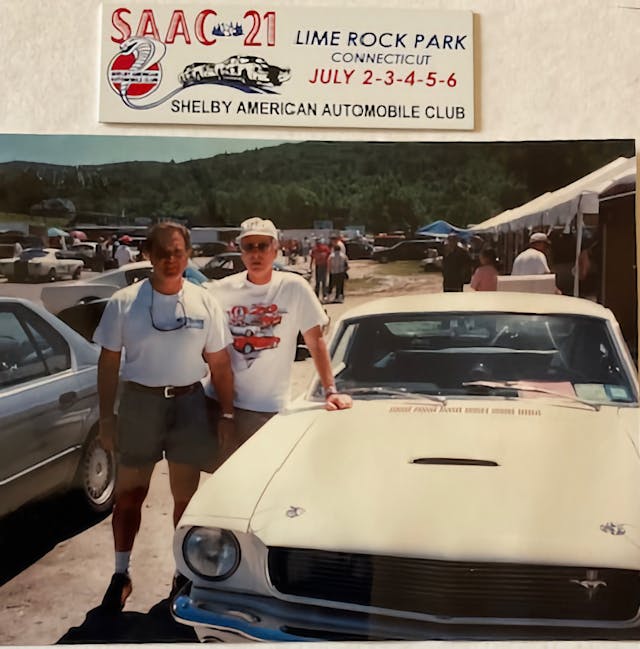
As documented in the book “Ford Total Performance” by Martyn L. Schorr, who knew Kolb personally, this go-getter revved up Shelby sales and had Carroll Shelby’s ear regarding vehicle improvements. Ford then asked him to set up and manage a Shelby “dealer within a dealership” at the company-owned Gotham Ford store in Manhattan. When the Shelby program ended in 1970, Gotham was #1, with 479 total Shelby-branded cars sold. Larsen was #2, with 319. Many years later, Klein and Kolb met up for a photo at a Shelby national convention.
Richard’s Shelby memories:
Hagerty: When did you buy the Shelby?
RK: In March 1966, and I didn’t have to order it. I just walked into Larsen Ford and bought it. They had three GT350s and one 289 Cobra on the showroom floor. The sticker price was $4400. I paid $4000. That was a lot of money in 1966. I wasn’t making much more than that per year.
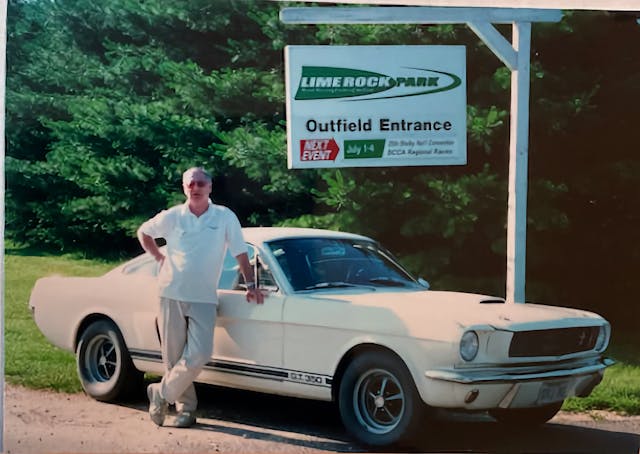
Hagerty: Why the GT350?
RK: A friend in our sports car club had a ’65 GT350, which I got to ride in. I didn’t think I’d want one, because it was more like a race car than a passenger car. But we decided to get the ’66 Shelby, which had some changes. It had enough power to make up time when we were late and lost. It had enough room, too. We put air conditioning in it, so it was comfortable. My other partner, Richard Leslie, and I did a lot of the mechanical and electrical work to install the rally equipment.
Hagerty: How often were you rallying?
RK: Sometimes we’d do three days a week. Friday night, a Saturday, and a Sunday rally locally. It was an obsession. Our first big win with the Shelby was the Jersey 500 in northern New Jersey in September ’66. We did national rallies that were long weekends. The MG 1,000 was a four-day rally. We did five or six of those and won in 1968. The car was very reliable.

Hagerty: Is rallying how you put on most of the car’s miles?
RK: If we went on a 500-mile rally, we might have to drive 300 miles to get there, put 500 miles on, and then drive 300 miles home. With all the local rallies, we’d put 200 miles on in a day. The MG 1,000 rallies were more like 1200 miles. And of course, you had to drive to the start and drive home from the finish. That’s how the miles added up.
Hagerty: Do you still rally the car?
RK: Yes, I do! We recently took it on a local rally tour from New Canaan, Connecticut, to Lime Rock Park. And three times this year we’re going up to the Catskill Mountains in New York for all-day rallies.

Hagerty: You mentioned some restoration. How much work was done?
RK: It was not what people today call a full restoration. The car never had any accidents or rust. We repainted it. We did the interior. But it still has all the original glass, all the original chrome trim on the windows, and so forth. When we took the rear springs out, there was no arc in them. It still has the original engine and transmission. I had previously changed the axle ratio from 3.89:1 to 3.25:1 for driving out to a Shelby convention in Elkhart Lake, Wisconsin. What a difference it made in lowering the rpm and noise! I still have the 3.89. I’ll never go back to it, but at least I have it.
Hagerty: A former student did the work?
RK: Yes, Bob Aliberto. He later became a friend and an industrial arts teacher himself. He was also a competitive Shelby racer, and he opened a business, Eastern Mustang in Poughkeepsie, New York. Unfortunately, he died suddenly in February this year.
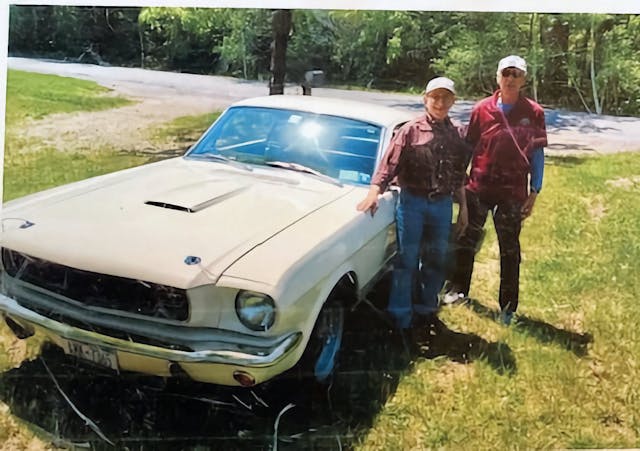
Hagerty: Are there any memories with the car that really stand out?
RK: We won a lot of rallies, and after we finished rallying the car, we took it to a lot of car shows and concours events. To me, the best award came from a local car show, the Alden Sherman Classic in Weston, Connecticut. The award was for the car that the judges would like to drive home. That to me was better than any other trophy we ever got.
Hagerty: The Shelby was just in the Greenwich Concours. Was that its first time?
RK: No, the first time I took it to Greenwich was in 1998. Other concours event chairmen would see the car and invite me to their events. Bill Warner [founder of The Amelia Island Concours d’ Elegance] was the first or second that asked. The car was also in the Meadowbrook Concours in Michigan [now the Hagerty Detroit Concours]. Last year we drove it to the Misselwood Concours in Beverly, Massachusetts. We got stuck in traffic for an extra hour, but the car did fine.
Hagerty: Do we even have to ask if the GT350 is a forever keeper?
RK: It’s a piece of history. We’re not getting rid of it, and we’ll keep driving it.
__
Car: 1966 Shelby GT350
Owner: Richard Klein
Home: Yorktown Heights, New York
Delivery date: March, 1966
***
Are you the original owner of a classic car or do you know someone who is? Send us a photo and a bit of background at editor@hagerty.com—you might get featured in our next installment!
Check out the Hagerty Media homepage so you don’t miss a single story, or better yet, bookmark it. To get our best stories delivered right to your inbox, subscribe to our newsletters.



Awesome story. I love seeing the car being driven and raced!
Great story ! Nice car, too: I’ve always liked the ’66 quarter windows, and I prefer no stripes across the top, a to me eye the GT350s look a bit cluttered with that decoration.
I’m thinking the traction bar, diff and exhaust changes saved Shelby some money and build tine; the racers would change some of that stuff on their own, sometimes beyond the ’65 spec, and the folks who bought them as street cars wouldn’t mind the partial civilization.
What an awesome story! Congrats to Richard for his passion and commitment to his Shelby – fantastic to build lifelong memories and friends through rallying. Love to see profiles on his other special cars too!
Also congrats to Hagerty and Jim Koscs for such a great feature – always look forward to reading the original owner series.
I remember this car from the past. I’m surprised that stores like this are even allowed because some people are so hung up on adding miles to their odometer. These cars were built to be driven, and this one actually is driven. Great job!!!! Keep it up.
Richard was my shop teacher in 1963 & 1967 in Yorktown. I remember him talking about rallye racing.
Hi. Friend just found the article. There are some cars you can’t forget. Last name please. 33 years teaching I had lots of students.
Richard
I have a ’65 K-motor in my 3WD Deuce coupe. That sweet thing will keep up with any traffic on I-5.
Brings back memories of my college days. The Ford dealer in Mayfield Heights, Ohio, had a ‘66 unsold GT-350 that I test drove, and a 427 Cobra SC on the showroom floor for less than $8000.
Robbie Ford in Dorchester, MA had a red ‘67 GT-350 with supercharger that was unsold in 1968 when I was car shopping.
Auto Engineering in Lexington, MA let me test drive a white 289 Cobra with 10,000 miles that was on their used car lot for $4000. Nice car, just not practical for a young college kid.
So many collector cars, so little time!
Richard was also my shop teacher. Remember all the crazy corvairs he had before he bought this. If I remember correctly he used to daily drive this to work when new.
Justin. You have a great memory. Those Corvairs were always a work in progress. Not unsafe at any speed in you drove carefully.
Also, Richard was one of my two Yorktown Jr. High School Industrial Art’s (“Shop”) Teacher (Grade 7-8); having cars at or near our classroom was wild. Also, the two teachers wore Lab style coats, giving the impression they were scientists. Shop was not an elective course in 1967, which was quite fortunate I suspect. I still possess the obligatory Bowling Pin / wooden book-end deliverables. Presently an owner of a 1967 Ford Country Squire which used quite frequently in film & TV (re: story by A.J. Baime WSJ) ..also insured by Hagerty. Many thanks for publishing the story on Mr. Klein and the ’66 Shelby
Hi. Just found article. Those were the good old days in education. I think today’s students are missing some skills we learned. Car still a blast.
May have already posted; Richard was a true influencer. Industrial Arts was mandatory course in ‘66-67 time frame. The Shelby was present when his class was being taught…; still have the obligatory Cutting Board, Bowling Pin lamp projects he guided on. I am a long time fan of Haggerty for coverage on our ‘67 Ford Country Squire Station Wagon ( re WSJ story by AJ Blaine). A ‘65 GT 350 sold today on BAT for >$350K…so cool.
It’s great hearing from past students that remember the car. At Lime Rock Concours in 2014 it was first in class for Shelby’s .